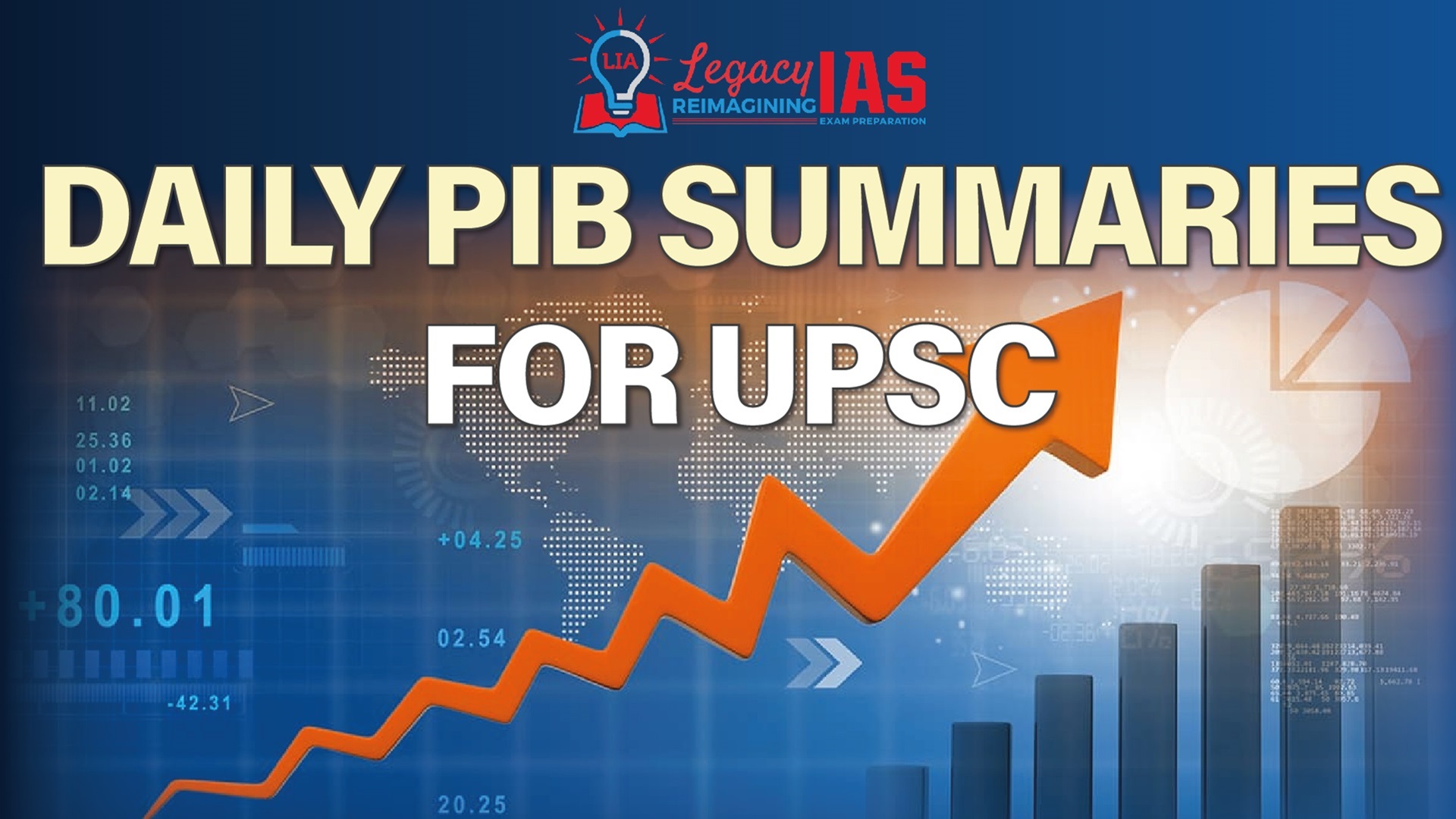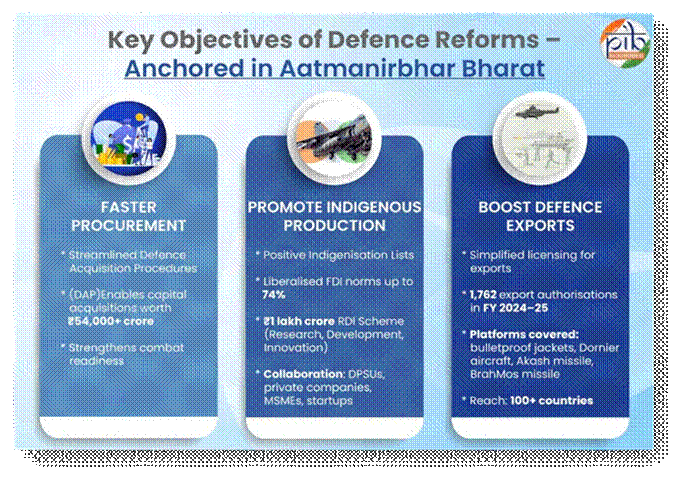
Content
- Defence Atmanirbharta: Record Production and Exports
- World Fisheries Day 2025: Strengthening Marine Resources & Livelihoods
Defence Atmanirbharta: Record Production and Exports
Why is this in the News?
- India recorded highest-ever defence production: ₹1.54 lakh crore (FY 2024–25).
- Defence exports hit₹23,622 crore, up from less than ₹1,000 crore in 2014.
- 16,000 MSMEs, 462 companies with 788 industrial licences, expanded role in indigenous manufacturing.
- Government targets₹3 lakh crore production and₹50,000 crore exports by 2029.
- DAP 2020 + DPM 2025 reforms → fastest procurement era + highest-ever domestic contracting.
Relevance :
- GS 2 (Governance, Policy, Institutions):
– Defence procurement reforms (DAP 2020, DPM 2025).
– Institutional strengthening, regulatory liberalisation, FDI norms, export governance (OGEL).
– Role of MoD, DPSUs, inter-agency coordination in defence industrialisation.
• GS 3 (Security, Economy, S&T):
– Indigenous defence production, innovation, R&D ecosystem (iDEX, DRDO TDF, DIA-CoEs).
– MSME integration, defence corridors, industrial licensing.
– Defence exports, strategic autonomy, technology sovereignty.
– Modernisation of armed forces, reduced import-dependence, multi-domain capabilities.
Context
- India was historically 65–70% import-dependent in defence.
- Policy reforms since 2014 aimed at self-reliance, reducing import bills, boosting exports, strengthening R&D, and widening private participation.
- Atmanirbharta in defence is now a strategic, economic, technological, and geopolitical priority.

Pre-Reform Challenges (Before 2014–15)
- Slow, multi-layered procurement → capability gaps.
- High import dependence → FX drain, supply-chain vulnerabilities during crises.
- Private sector largely excluded; PSU monopoly limited innovation.
- Defence exports extremely low (₹686 crore in FY 2013–14).
- R&D weak; academia–industry links minimal.
- Fragmented policies → no integrated plan for production + technology + exports.
Policy Response & Objectives of Reforms
- Atmanirbhar Bharat in defence aims at a competitive, innovation-led ecosystem.
- Key objectives:
- Faster procurement with DAP 2020, DAC clearances.
- Promote indigenous design via POSITIVE INDIGENISATION LISTS.
- Liberalised FDI up to 74% automatic / 100% govt route.
- ₹1 lakh crore RDI Scheme for deep-tech R&D.
- Build export capacity via simplified processes, OGEL, digital authorisations.
- Integrate procurement, innovation, production, and global market access under one framework.

Defence Acquisition Reform (DAP 2020)
- Indian-first acquisition hierarchy: Buy Indian-IDDM at the top.
- Reduced timelines via digital approvals, simplified contracting.
- Dedicated provisions for AI, cyber, robotics, space, autonomous systems.
- Industry-friendly measures via iDEX, start-up ecosystem integration.
- Empowered acquisition wings → fewer procedural chokepoints.
Defence Procurement Manual (DPM) 2025
- Standardisation across Services + MoD for revenue procurement (~₹1 lakh crore annually).
- Lower liquidated damages for indigenisation projects (0.1%/week).
- Guaranteed 5-year orders for indigenous products.
- No need for NOC from former OFB.
- Fully digital, transparent system → faster contract execution.
Domestic Defence Production: Key Trends
a) Record Output
- ₹1.54 lakh crore in FY 2024–25.
- From ₹46,429 crore (2014–15) → 174% rise in indigenous production (FY 2023–24).
- Government target: ₹3 lakh crore by 2029.
b) DPSU + Private Sector Dynamics
- DPSUs: 77% of total production.
- Private sector: 23%, rising from 21% last year → strong upward trend.
c) Defence Industrial Corridors
- UPDIC + TNDIC:
- Investment realised: ₹9,145 crore.
- 289 MoUs, potential: ₹66,423 crore.
d) Expansion of Defence Ecosystem
- DRDO pushes deep-tech with ₹500 crore TDF vertical.
- 15 DIA-CoEs linking academia, start-ups, R&D labs.
- OFB corporatisation → 7 DPSUs with better autonomy and efficiency.
- 16,000 MSMEs integrated into supply chain.
e) Industrial Licences & Investment Climate
- 788 licences issued to 462 companies.
- Export portal approvals increased 17% YoY (1,762 approvals).
- Record signing of 193 MoD contracts worth ₹2.09 lakh crore, of which ₹1.69 lakh crore to domestic industry.
Defence Acquisitions (2024–25): Rapid Modernisation
a) Budget Push
- Capital allocation (2024–25): ₹1.72 lakh crore (+20% over FY 2022–23).
b) Key DAC Approvals
- March 2025: ₹54,000 crore (T-90 engines, Varunastra torpedoes, AEW&C).
- July 2025: ₹1.05 lakh crore (EW systems, SAMs, MCM vessels, autonomous vessels).
- Aug 2025: ₹67,000 crore (BMP night sights, Compact Autonomous craft, BrahMos FCS).
- Oct 2025: ₹79,000 crore (NAMIS Mk-II, GBMES, LPDs, ALWT torpedoes, CLRTSDS).
c) Strategic Impacts
- 65% of defence equipment now domestically manufactured (reversing earlier import dependency).
- Multi-domain modernisation with indigenous platforms.
Defence Exports: India’s Global Rise
a) Export Record
- FY 2024–25: ₹23,622 crore (+12% YoY).
- Private sector: ₹15,233 crore.
- DPSUs: ₹8,389 crore (42.85% growth).
- India now exports to ~80–100 countries.
b) Export Basket
- Bulletproof jackets, patrol boats, UAVs, radars, torpedoes, sub-systems, components.
- Dornier aircraft, Chetak helicopters, interceptor boats.
- Expanding footprint in South-East Asia, Africa, Latin America.
c) Export Facilitation
- OGEL licences, digital portal, rationalised SOPs.
- Export processes shifted from weeks to days.
- Defence exports used as defence diplomacy → deeper strategic partnerships.
Strategic Significance
- Enhances national security by reducing critical dependencies.
- Boosts economy, jobs, MSMEs, tech innovation.
- Strengthens geopolitical leverage through defence diplomacy.
- Enhances India’s standing as a reliable global defence supplier.
Conclusion
- India’s defence sector has moved from import-dependent to innovation-driven self-reliance.
- Production, procurement, R&D, private participation, and exports have all hit record highs.
- With DAP 2020 + DPM 2025 + Defence Corridors + MSME ecosystem + export reforms, India is transitioning into a global defence manufacturing hub.
- The trajectory is strongly aligned with the targets of ₹3 lakh crore production and ₹50,000 crore exports by 2029, marking a decisive shift towards strategic autonomy.
World Fisheries Day 2025: Strengthening Marine Resources & Livelihoods
Why in the News?
- India observed World Fisheries Day 2025 (21 Nov) with focus on sustainability, blue economy, and value addition in seafood exports.
- India released the National Framework on Traceability in Fisheries & Aquaculture.
- GST on key seafood products reduced 12% → 5%, boosting affordability and export competitiveness.
- Marine product exports (Oct 2024 → Oct 2025) rose 11.08% (US$ 0.81B → US$ 0.90B).
- India remains 2nd-largest fish producer and top global shrimp producer.
- Major launches: SOPs for Mariculture, Smart Harbour Guidelines, Reservoir Fisheries Guidelines, Compendium on Coastal Aquaculture, plus traceability standards.
- Delegations from 27 nations participated, signalling India’s global leadership in the blue economy.
Relevance :
- GS 1 (Society & Livelihoods):
– Socio-economic profile of fishing communities; role in coastal livelihoods; women’s participation.
– Impact of climate risks on fisher households; migration, vulnerability, resilience.
- GS 2 (Governance, Welfare Schemes, Digital Delivery):
– PMMSY, PM-MKSSY, FIDF, EEZ Rules 2025, Smart Harbour Guidelines.
– Digital governance: ReALCRaft, VCSS, NABHMITRA, Marine Fisheries Census 2025.
– Traceability framework, SPS standards, regulatory reforms, institutional coordination (DoF, MPEDA).
• GS 3 (Economy, Environment, Agriculture & Blue Economy):
– Fisheries contribution to GDP, exports, processed seafood value chain.
– Blue economy expansion, mariculture, deep-sea fishing regulation, sustainability norms.
– Climate-resilient infrastructure, biodiversity conservation, SDG-14 alignment.
Importance of Fisheries
- Food Security: Key protein source, low carbon footprint.
- Livelihoods: Supports 30+ million people; crucial for coastal & inland rural economies.
- Blue Economy: High multiplier sectors (exports, processing, mariculture, deep-sea fishing).
- Ecosystem Role: Biodiversity management, climate resilience, mitigation of overfishing.

India’s Fisheries Growth – Data & Trends
- Fish production doubled:
- 96 lakh tonnes (2013–14) → 195 lakh tonnes (2024–25).
- Inland fisheries grew 140%.
- Seafood exports (2024–25): ₹62,408 crore.
- Coastal states:
- 3,477 villages,
- Contribute 72% of production, 76% of exports.
- Infrastructure push:
- 730 cold storages,
- 26,348 transport units,
- 6,410 fish kiosks,
- 202 retail & 21 wholesale markets.
GST Reforms (2025) – Significance
- Key marine products GST cut: 12% → 5%.
- Impacts:
- Strengthens value addition & processed seafood industry.
- Boosts domestic affordability.
- Improves export price competitiveness.
- Encourages processed seafood units in coastal clusters.
Key Schemes Driving the Blue Economy
1.Pradhan Mantri Matsya Sampada Yojana (PMMSY)
Objective: Blue Revolution through sustainable, inclusive growth.
Investment: ₹20,312 crore (2020–21 to 2025–26).
Achievements:
- Cold-chain + processing infra (as above).
- Transformation of 100 Coastal Fishing Villages into Climate-Resilient CFVs.
- Women beneficiaries: 60% assistance (vs 40% others).
- Financial inclusion:
- Kisan Credit Card coverage,
- SHGs, cooperatives, training.
Significance:
- Reduces post-harvest losses, improves climate resilience, increases incomes.
2.PM Matsya Kisan Samridhi Sah-Yojana (PM-MKSSY)
Investment: ₹6,000 crore, duration 2023–24 to 2026–27.
Core: Formalisation + insurance + traceability across aquaculture value chain.
Key Features:
- Premium support: 40% (max ₹25,000/ha, cap ₹1 lakh).
- Farms up to 4 ha WSA eligible.
- ₹11.84 crore sanctioned (as of Apr 2025).
- Supported by World Bank–AFD mission for design & implementation.
Significance:
- Brings aquaculture into formal credit & insurance net.
- Protects small farmers’ incomes from climate shocks/disease.
3. Fisheries & Aquaculture Infrastructure Development Fund (FIDF)
Corpus: ₹7,522.48 crore (extended to 2026).
Features:
- Concessional finance (interest subvention 3%, effective rate ≥ 5%).
- Nodal agencies: NABARD, NCDC, Scheduled Banks.
- Digital FIDF portal for project proposals.
Status:
- 178 projects, investment ₹6,369.79 crore, subvention ₹4,261.21 crore (as of July 2025).
Significance:
- Enhances post-harvest, harbour, deep-sea & processing infrastructure nationwide.
4. Sustainable Harnessing Rules for the EEZ (2025)
Purpose: Regulate deep-sea fishing, improve governance, boost incomes.
Key Provisions:
- Priority access to cooperatives & FFPOs for deep-sea fishing licences.
- Digital Access Pass System via ReALCraft for mechanised vessels.
- Traditional fishers exempt.
- Integration with MPEDA + EIC for quality, traceability, certification.
- Ban on destructive fishing methods; promotion of seaweed farming & sea-cage farming.
Significance:
- Unlocks deep-sea potential.
- Ensures sustainability & global compliance.
- Strengthens income diversification.
5. ReALCRaft – Digital Governance Platform
- End-to-end online vessel registration, licensing, payments.
- Also handles ownership transfer, hypothecation, vessel modifications.
- Physical visit needed only for biometrics + original document check.
Governance Gains:
- Transparency, reduced delays, better compliance.
- Improved marine monitoring and safety.
6. Vessel Communication & Support System (VCSS)
- Over 36,000 transponders distributed (as of Jan 2025).
- Enhances real-time tracking, safety, search & rescue.
7. NABHMITRA
- Safety + communication for small vessels (<20m).
- SOS alerts, location sharing, resource mapping.
- Strengthens enforcement & reduces maritime accidents.
Marine Fisheries Census 2025 (MFC 2025)
Timeline: 3 Nov – 18 Dec 2025.
Coverage:
- 1.2 million households,
- 5,000 villages,
- 13 coastal States/UTs.
Digital Innovations:
- VyAS–NAV, VyAS–BHARAT, VyAS–SUTRA apps.
- Real-time geo-referenced enumeration.
- Integrated with National Fisheries Digital Platform (NFDP).
Outcome:
- First-ever socio-economic profiling of fisher communities.
- Direct linkage with PM-MKSSY entitlements.
Significance: Evidence-based policymaking for climate resilience.
MPEDA’s Role
- Ensures certification, traceability, quality compliance.
- Promotes eco-friendly aquaculture & responsible fishing.
- Expands market access, trains exporters, farmers, processors.
- Drives research, new technologies, value-added products.
Thematic Focus 2025: “India’s Blue Transformation: Strengthening Value Addition in Seafood Exports”
- Emphasis on:
- Processing infrastructure,
- Quality standards,
- Traceability framework,
- Low-GST,
- Deep-sea governance,
- Smart harbours,
- Digital platforms.
Strategic Significance
- Enhances:
- Livelihoods of fishers,
- Marine biodiversity protection,
- Export competitiveness,
- Formalisation & insurance penetration,
- Blue economy contribution to GDP,
- Women’s leadership in the sector.
- Advances India toward SDG 14: Life Below Water.
Conclusion
India’s fisheries sector is undergoing a structural transformation driven by sustainability, digital governance, deep-sea diversification, value addition, and global compliance. With PMMSY, PM-MKSSY, EEZ Rules, FIDF expansion, and digital systems like ReALCRaft and MFC 2025, India is strengthening livelihoods while responsibly managing marine ecosystems. The trajectory reflects a shift from volume-led growth toward value-led, climate-resilient, export-competitive blue economy development.PIB Summaries 20 November 2025
